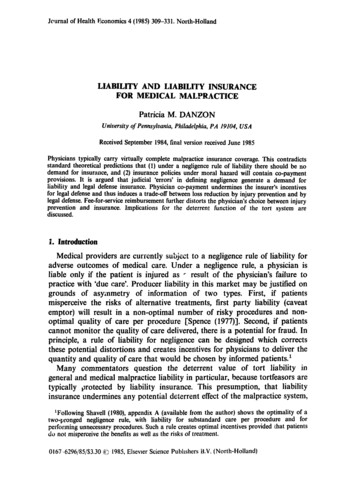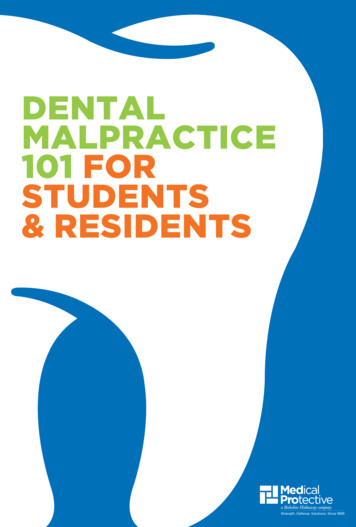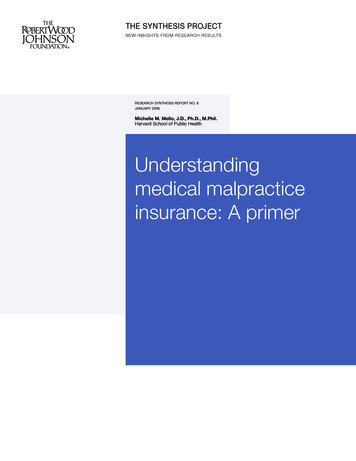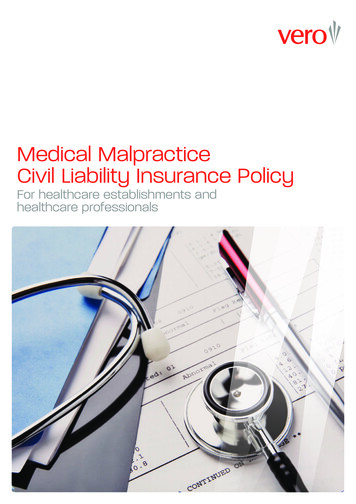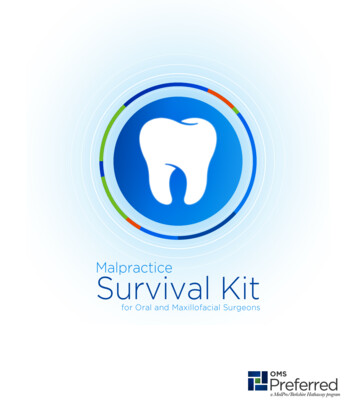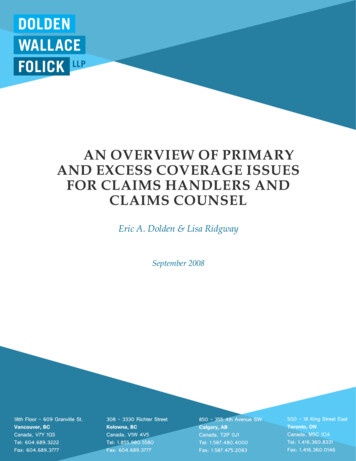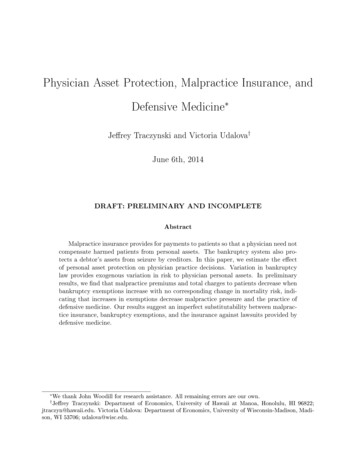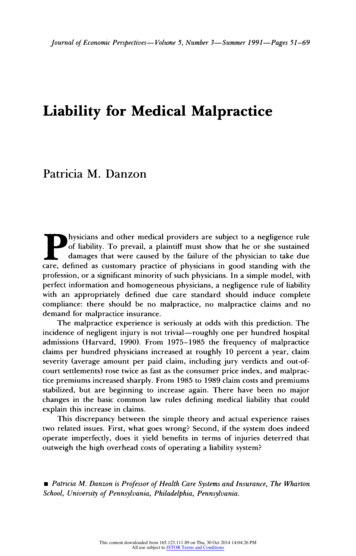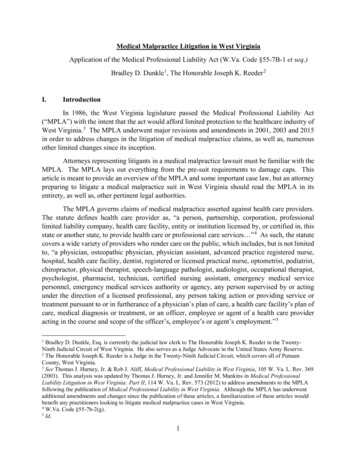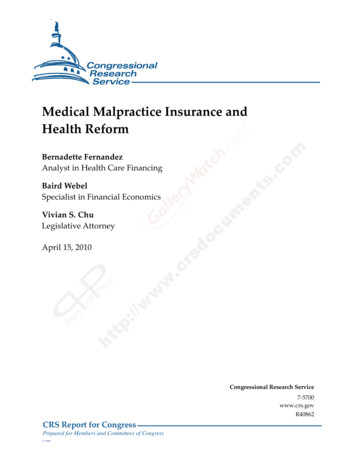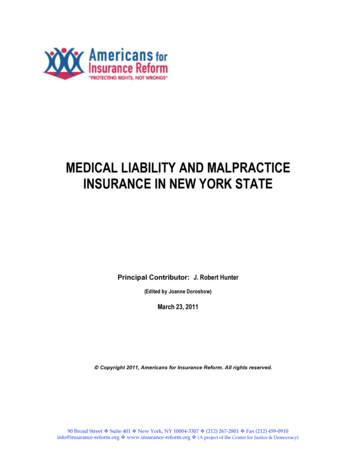
Transcription
MEDICAL LIABILITY AND MALPRACTICEINSURANCE IN NEW YORK STATEPrincipal Contributor: J. Robert Hunter(Edited by Joanne Doroshow)March 23, 2011 Copyright 2011, Americans for Insurance Reform. All rights reserved.90 Broad Street Suite 401 New York, NY 10004-3307 (212) 267-2801 Fax (212) 459-0910info@insurance-reform.org www.insurance-reform.org (A project of the Center for Justice & Democracy)
MEDICAL LIABILITY AND MALPRACTICE INSURANCEIN NEW YORK STATESUMMARY/KEY FINDINGSAmericans for Insurance Reform (AIR) is a coalition of nearly 100 consumer and public interestgroups around the country, including New York State. Under the direction of actuary J. RobertHunter, 1 AIR has produced the most comprehensive review of medical malpractice premiumsand claims, to date. Based on its analysis, AIR finds: Inflation-adjusted payouts per doctor in New York State have been stable, have failed toincrease in recent years, and are comparable to what they were in the early 1980s. Inflation-adjusted premiums per doctor premiums in New York State are among thelowest they have been in over 30 years, comparable to what they were in the mid-1970s. Loss ratios are not unusal; they clearly display no “crisis,” but rather that medicalmalpractice insurers have been performing well in New York State.AIR concludes that there is absolutely no reason to further limit the liability of doctors andhospitals, who already benefit from numerous liability protections in New York State for theirnegligence.21Hunter is Director of Insurance for the Consumer Federation of America, a federation of some 300 pro-consumergroups with over 50 million Americans as members of whom over 5 million are New York members. He wasformerly the Commissioner of Insurance for the State of Texas, the Federal Insurance Administrator under bothPresidents Carter and Ford, and President and Founder of the National Insurance Consumer Organization. As aconsultant on public policy and actuarial issues for various government agencies, his clients have included the U.S.Department of Housing and Urban Development, the General Accounting Office, and the Environmental ProtectionAgency, as well as state governments including California, Florida, Georgia, Massachusetts, Maine, North Carolina,New Jersey, New York, Oklahoma, South Carolina and Texas. Other experience includes work in the private sector,including as Associate Actuary for the Mutual Insurance Advisory Association and Mutual Insurance Rating Bureau(now AIPSO), Actuarial Supervisor for the National Bureau of Casualty Underwriters (now ISO), and Underwriter,Atlantic Mutual and Centennial Insurance Companies. His awards include the Award for Excellent Service for theSecretary of the Department of Housing and Urban Development (HUD), for work performed from 1971 to 1977,the Esther Peterson Award for lifetime service to consumers in 2002, and twice, the Schraeder-Nelson PublicationsAward for article of the year: in 2002 for “Enron’s Impact on State Insurance Regulation” and in 2007, for “HowRegulators Can Return P/C Profits to Reasonable Levels,” Regulator Magazine, Insurance Regulatory Examiner’sSociety. He is the author of numerous publications on insurance and related topics and has served as an ExecutiveCommittee member and advisor to the National Association of Insurance Commissioners (NAIC). Over the pastdecades, Mr. Hunter has testified in every state in the Union on the medical malpractice insurance cycle and relatedpremium spikes.2In the mid-1980s, New York enacted three out of four of the “medical liability reform” agenda items pushed by thecorporate-backed American Tort Reform Association: a sliding scale limit on attorney’s contingent fees; prohibitionof lump sum compensation payments to victims; and abolition of the collateral source. These laws added to legalobstacles that New Yorkers already faced, which residents in most other states do not: a restrictive statute oflimitations law that begins to runs from the date of a patient’s injury as opposed to its discovery; and, an archaic“wrongful death” law dating from the 1800s that does not allow compensation for emotional loss of a child who is2
THE CONTEXT: HISTORIC CYCLES AND UNIQUE NEW YORK ISSUESMedical liability insurance is part of the property/casualty sector of the insurance industry. Thisindustry’s profit levels are cyclical, with insurance premium growth fluctuating during hard andsoft market conditions. This is because insurance companies make most of their profits, orreturn on net worth, from investment income. During years of high interest rates and/orexcellent insurer profits, insurance companies engage in fierce competition for premium dollarsto invest for maximum return, particularly in “long-tail” lines – where the insurers holdpremiums for years before paying claims – like medical malpractice. Due to this intensecompetition, insurers may actually underprice their policies (with premiums growing belowinflation) in order to get premium dollars to invest. This period of intense competition and stableor dropping insurance rates is known as the “soft” insurance market.When interest rates drop or the economy turns causing investment decreases, or the cumulativeprice cuts during the soft market years make profits unbearably low, the industry responds bysharply increasing premiums and reducing coverage, creating a “hard” insurance market. Thisusually degenerates into a “liability insurance crisis” often with sudden high rate hikes that maylast for a few years. Hard markets are followed by soft markets, when rates stabilize once again.The country – and New York State - experienced a hard insurance market in the mid-1970s,particularly in the medical malpractice and product liability lines of insurance. A more severecrisis took place in the mid-1980s, when most liability insurance was impacted. Again, in 2001 a“hard market” took hold.In addition, New York State’s medical malpractice insurance market has had a unique problemin recent years. This was described in December 17, 2007 “Report of J. Robert Hunter on NewYork State Medical Malpractice Insurance Situation,”3 specifically that in the 1990s, the Stateappropriated close to a billion dollars from the reserves of the Medical Malpractice InsuranceAssociation (MMIA) - established by the State as the medical malpractice insurer of last resort –to close gaps in the State’s operating budget. In 2001, the State finally dissolved MMIAreplacing it with the Medical Malpractice Insurance Plan (MMIP), an assigned risk plan in whichall medical malpractice insurers participate. Unfortunately, because the State had drainedMMIA’s money, MMIP had accumulated a deficit that, by law, had to be shouldered by the fewcompanies selling malpractice insurance in the state. Governor Spitzer established a MedicalMalpractice Advisory Task Force to come up with ways to resolve this MMIP problem.The amount of this deficit was never clear. In his report, Hunter found at the time that the statemedical malpractice insurance deficit was based on figures that the insurance departmentadmitted might not be accurate yet is asserted without caveat. Hunter strongly cautioned againstany precipitous action and urged the department to evaluate this situation on a year-by-year cashflow basis. Notably, in 2008, the Task Force stopped meeting and never issued a report.Governor Patterson later signed two different pieces of legislation to freeze medical malpracticekilled by medical malpractice.3See, terAnalysispdf.pdf.3
insurance rates. During this period, there was never any “spike” in insurance claims, and in fact,claims remained quite stable.This new study is an extensive review of medical malpractice insurance rate activity in NewYork from 1975 through 2008 – over three decades of data prepared by A.M. Best that includesall that medical malpractice insurers paid in jury awards, settlements and other costs, andcompared these actual costs with the premiums that insurers charged doctors, as well as with theeconomic cycle of the insurance industry. The data shows (see data in Appendix A): Inflation-adjusted payouts per doctor have been stable, have failed to increase in recent years,and is comparable to what they were in the early 1980s. Inflation-adjusted premiums per doctor premiums are among the lowest they have been inover 30 years, comparable to what they were in the mid-1970s.DPW is “direct premiums written.” PL is “paid losses.”As this chart shows, at no time in these 30 years were increases in premiums connected to anyincreases in claims or payouts. Rather, they reflected the well-known cyclical insurance cycle.4
Loss RatioLoss ratios compares the premiums that insurers take in and the money expected to be paid inclaims. The lower the loss ratio, the less the insurer expects to pay for claims and the moreprofitable the insurer likely is (assuming all other things are equal.) A low loss ratio alsoindicates a very inefficient delivery system for benefits.According to our analysis, the loss ratio for medical malpractice insurers was 60.5% in 2008.Put another way, medical malpractice insurers believe they will pay out in claims only 60.5 centsfor each premium dollar they take in. The rest goes towards overhead and profit. This profit isin addition to the profit the insurer also makes by investing premiums during the “float” period.(The “float” occurs between the time when premiums are taken in by the insurer and losses paidout—e.g., while there is about a 15 month lag for auto insurance, there is a much longer 5 to 10year lag for medical malpractice, allowing for more investment income.)Given all these factors, a 60.1 percent loss ratio is low and helps demonstrate how well medicalmalpractice insurers have been performing in New York State.5
APPENDIX AYEARDirectPremiumsWritten (DPW)Direct LossesPaid (PL)LossRatioNumber ofDoctors InNew YorkMed.Inflation(cpi-u)DPWPerDoctorPL PerDoctorYRDPW PerDoctor2001 PL PerDoctor2001 1975 112,651,522 31,039,31027.6%4639347.5 2,4281976127,679,76530,018,02423.5%4693552.0 2,720 6691975 16,522 4,552 6401976 16,9081977160,860,47541,003,25525.5%4747857.0 3,975 3,388 8641977 19,2111978166,062,89158,520,23235.2%48020 4,89761.8 3,458 1,2191978 18,086 107,385,43350.6%4856367.5 3,892 1,7541979 18,635 8,3994910574.9 4,321 2,1871980 18,6441981252,103,328112,760,851 9,43644.7%5056282.9 4,986 2,2301981 19,4391982271,923,193 8,695148,956,32654.8%5202092.5 5,227 2,8631982 18,264 6 5,483 3,5341983 17,617 11,353283,861,417205,377,83972.4%54935106.8 5,167 3,7391984 15,637 11,3141985530,787,017230,263,81143.4%56392113.5 9,412 4,0831985 26,803 11,6271986660,307,449272,951,92641.3%57262122.0 11,531 4,7671986 30,549 12,6281987712,816,848332,134,83346.6%58133130.1 12,262 5,7131987 30,461 14,1931988865,125,258383,778,73644.4%59003138.6 14,662 6,5041988 34,191 15,1681989884,623,310402,302,26945.5%59874149.3 14,775 6,7191989 31,984 14,5451990854,403,798362,843,03842.5%60744162.8 14,066 5,9731990 27,924 11,8591991793,879,724409,388,83451.6%62745177.0 12,652 6,5251991 23,103 11,9141992811,974,970559,175,76468.9%64746190.1 12,541 8,6361992 21,322 14,6831993870,300,422615,013,46870.7%66748201.4 13,039 9,2141993 20,924 14,7861994923,163,546576,724,48362.5%68750211.0 13,428 8,3891994 20,568 12,8491995905,070,538544,403,41860.2%70751220.5 12,792 7,6951995 18,750 11,2781996822,075,016591,710,86872.0%72314228.2 11,368 8,1831996 16,101 11,5891997816,663,055598,744,43173.3%73877234.6 11,054 8,1051997 15,229 11,1651998886,935,822634,166,91371.5%75440242.1 11,757 8,4061998 15,695 11,2221999900,034,082795,112,33688.3%77003250.6 11,688 10,3261999 15,074 13,3172000849,687,717700,772,37482.5%78566260.8 10,815 8,9202000 13,403 11,0542001881,194,813698,555,72079.3%80129272.8 10,997 8,7182001 13,029 10,3292002992,924,544732,555,31273.8%80667285.6 12,309 9,0812002 13,929 10,27720031,107,374,159781,788,78270.6%81199297.1 13,638 9,6282003 14,836 10,47420041,284,228,574980,901,47276.4%81716310.1 15,716 12,0042004 16,380 12,51120051,372,467,390935,093,27868.1%82301323.2 16,676 11,3622005 16,676 2 17,900 12,0262006 17,208 4 19,293 11,2882007 17,762 5 18, 755 11,3322008 16,650 10,060Sources:Premiums Written (Net), A.M. Best and Co., special data compilation for AIR, reporting data for as many years as separately available;Number of Total NonFed Doctors: U.S. Bureau of the CensusInflation Index: Bureau of Labor Statistics6
York State Medical Malpractice Insurance Situation,"3 specifically that in the 1990s, the State appropriated close to a billion dollars from the reserves of the Medical Malpractice Insurance Association (MMIA) - established by the State as the medical malpractice insurer of last resort - to close gaps in the State's operating budget.
